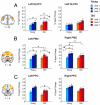Performance level modulates adult age differences in brain activation during spatial working memory
- PMID: 20018709
- PMCID: PMC2799744
- DOI: 10.1073/pnas.0908238106
Performance level modulates adult age differences in brain activation during spatial working memory
Abstract
Working memory (WM) shows pronounced age-related decline. Functional magnetic resonance imaging (fMRI) studies have revealed age differences in task-related brain activation. Evidence based primarily on episodic memory studies suggests that brain activation patterns can be modulated by task difficulty in both younger and older adults. In most fMRI aging studies on WM, however, performance level has not been considered, so that age differences in activation patterns are confounded with age differences in performance level. Here, we address this issue by comparing younger and older low and high performers in an event-related fMRI study. Thirty younger (20-30 years) and 30 older (60-70 years) healthy adults were tested with a spatial WM task with three load levels. A region-of-interest analysis revealed marked differences in the activation patterns between high and low performers in both age groups. Critically, among the older adults, a more "youth-like" load-dependent modulation of the blood oxygen level-dependent signal was associated with higher levels of spatial WM performance. These findings underscore the need of taking performance level into account when studying changes in functional brain activation patterns from early to late adulthood.
Conflict of interest statement
The authors declare no conflict of interest.
Figures






Similar articles
-
Functional and structural correlates of working memory performance and stability in healthy older adults.Brain Struct Funct. 2020 Jan;225(1):375-386. doi: 10.1007/s00429-019-02009-1. Epub 2019 Dec 23. Brain Struct Funct. 2020. PMID: 31873799
-
Load modulation of BOLD response and connectivity predicts working memory performance in younger and older adults.J Cogn Neurosci. 2011 Aug;23(8):2030-45. doi: 10.1162/jocn.2010.21560. Epub 2010 Sep 9. J Cogn Neurosci. 2011. PMID: 20828302
-
Dynamic range of frontoparietal functional modulation is associated with working memory capacity limitations in older adults.Brain Cogn. 2017 Nov;118:128-136. doi: 10.1016/j.bandc.2017.08.007. Epub 2017 Aug 31. Brain Cogn. 2017. PMID: 28865310 Free PMC article.
-
Neurophysiological signals of working memory in normal aging.Brain Res Cogn Brain Res. 2001 Jun;11(3):363-76. doi: 10.1016/s0926-6410(01)00009-x. Brain Res Cogn Brain Res. 2001. PMID: 11339986
-
The cognitive neuroscience of remembering.Nat Rev Neurosci. 2001 Sep;2(9):624-34. doi: 10.1038/35090048. Nat Rev Neurosci. 2001. PMID: 11533730 Review. No abstract available.
Cited by
-
The relationship between P3 amplitude and working memory performance differs in young and older adults.PLoS One. 2013 May 7;8(5):e63701. doi: 10.1371/journal.pone.0063701. Print 2013. PLoS One. 2013. PMID: 23667658 Free PMC article.
-
Working memory performance in the elderly relates to theta-alpha oscillations and is predicted by parahippocampal and striatal integrity.Sci Rep. 2019 Jan 24;9(1):706. doi: 10.1038/s41598-018-36793-3. Sci Rep. 2019. PMID: 30679512 Free PMC article.
-
The Effect of Cognitive Load on the Retrieval of Long-Term Memory: An fMRI Study.Front Hum Neurosci. 2021 Oct 13;15:700146. doi: 10.3389/fnhum.2021.700146. eCollection 2021. Front Hum Neurosci. 2021. PMID: 34720904 Free PMC article.
-
Load effects on spatial working memory performance are linked to distributed alpha and beta oscillations.Hum Brain Mapp. 2019 Aug 15;40(12):3682-3689. doi: 10.1002/hbm.24625. Epub 2019 May 11. Hum Brain Mapp. 2019. PMID: 31077487 Free PMC article.
-
Impact of changed positive and negative task-related brain activity on word-retrieval in aging.Neurobiol Aging. 2012 Apr;33(4):656-69. doi: 10.1016/j.neurobiolaging.2010.06.020. Epub 2010 Aug 8. Neurobiol Aging. 2012. PMID: 20696496 Free PMC article.
References
-
- Baddeley A. Working memory: Looking back and looking forward. Nat Rev Neurosci. 2003;4:829–839. - PubMed
-
- Babcock RL, Salthouse TA. Effects of increased processing demands on age differences in working memory. Psychol Aging. 1990;5:421–428. - PubMed
-
- West RL. An application of prefrontal cortex function theory to cognitive aging. Psychol Bull. 1996;120:272–292. - PubMed
-
- Park DC, et al. Models of visuospatial and verbal memory across the adult life span. Psychol Aging. 2002;17:299–320. - PubMed
Publication types
MeSH terms
LinkOut - more resources
Full Text Sources
Other Literature Sources
Medical

